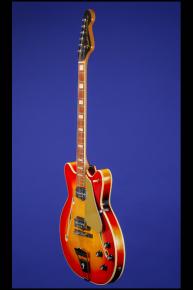A Near Mint 1967 Cherry Sunburst Coronado ll.
1967 Fender Coronado II.
This near mint guitar weighs just 5.90 lbs. and has a nut width of just over 1 5/8 inches and a scale length of 25 1/2 inches. 'Checker-Board' bound thinline double-cutaway hollow-body with two single-bound f-holes. Laminated maple body, one-piece maple neck with a medium profile, and bound rosewood fretboard with 21 frets and inlaid pearloid block position markers. Black faced headstock with "Fender" and "CORONADO II" in gold trim beside it. Neck dated "19JAN 67B." Single "butterfly" string tree. Individual Fender "F" tuners with octagonal metal buttons. Four-bolt neck plate with large Fender "F" logo and serial "502538" between the top two screws. Two specially designed DeArmond "passive" single-coil pickups with outputs of 9.13k and 10.86k. Four-layer (gold/white/black/white) plastic pickguard. Four controls (two volume, two tone) on lower treble bout plus three-way selector switch on the treble horn. Black plastic, seven-sided control knobs with metal tops. ABR-1 style bridge on rosewood base with individually adjustable metal saddles and specific Fender Coronado "trapeze"-style tailpiece with inset black plastic plaque with white plastic Fender "F" logo. This guitar is in totally original and near-mint (9.25) condition. Housed in the original five-latch Fender 'Victoria' black "shaped" hardshell case with orange plush lining (9.00).
According to Werner's List, the serial number range 501,282 to around 503,000 were shipped between September 1966 and January 1967.
"The Fender Coronado can be classified as a double-cutaway hollow-body electric guitar. Two models were produced from 1966 through 1967. The Fender Coronado I was the original single pickup design and the Coronado II, has an added bridge pickup. All Coronados were made in the USA…This is one of the few, true hollow-body electrics as it does not have solid wood blocking under the top. The tops are laminated and slightly arched with two generous, routed and bound f' holes in the top. The various colors and woods are finished with no-longer-available, high-gloss nitro-cellulose lacquer. The controls on the Coronado I consist of one neck pickup, one volume and one tone control. The Coronado II has two pickups, neck and bridge positions, two volume and two tone controls, as well as a three-position selector switch. The pickups are passive type, as the guitars were only made in 1966 and 1967. The body front, sides and back are constructed of laminated, domestic Beechwood and have a relatively thin, 'C' shaped maple neck topped with fingerboards of Indian rosewood. More sugar. The standard pickups are DeArmonds and the bridges are a free-floating, non-anchored, 'tune-o-matic' style, with a suspended tailpiece. The tuners are labeled Fender" (Wikipedia.com at http://en.wikipedia.org/wiki/Fender_Coronado).
"The Coronado guitars and basses, intended as competition for arch-rivals Gibson, were launched by Fender in 1966. They proved once again that Fender ought to stick with solidbody instruments, and none was successful…The Coronado thinline guitars were yet more creations from Roger Rossmeisl's Missile Way acoustic factory, and the first electric hollowbody designs to appear from Fender. Clearly, the company was being pushed by new owners CBS to compete with the successful 300-series thinline electrics marketed by the other big name in the guitar market, Gibson. The Coronados looked like conventional competitors for the Gibson models, with equal-double-cutaway bound bodies that sported large, stylized f-holes. But in fact, just like the earlier flat-tops, they employed the standard Fender bolt-on necks, as well as the company's distinctive headstock design. Options included a new vibrato tailpiece, and there was a 12-string version that used the Electric XII's large curved headstock design. Unfamiliar with some edge-binding techniques, factory hands had to re-do some of the work. To cover up burn marks caused by re-binding, the team devised a special white-to-brown shaded finish—Antigua—to salvage the scorched Coronados. Antigua-finish Coronados would go on sale over the next few years" (Tony Bacon, 50 Years of Fender, p. 44).












